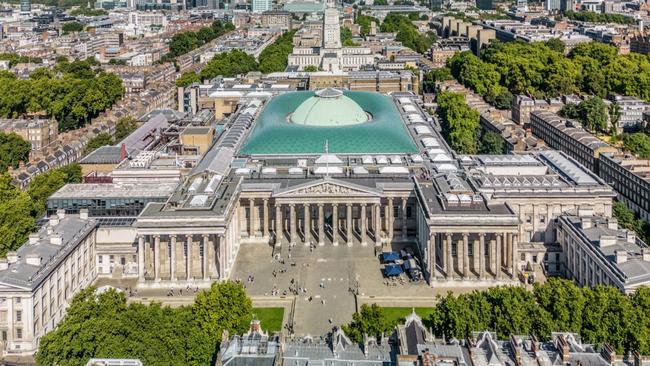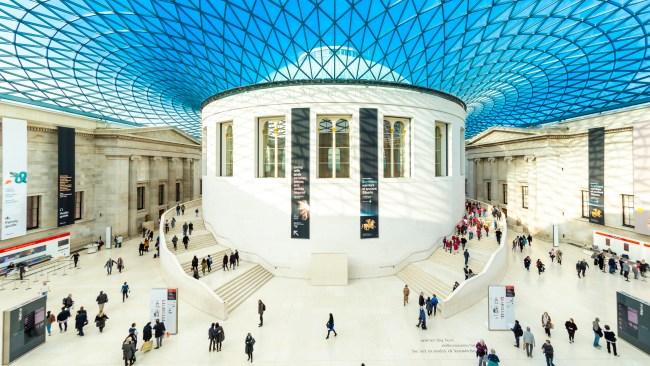I went to London’s top museums, this one is the most captivating
London is home to some of the best galleries and museums in the world, but the British Museum's collection is, for better or worse, absolutely fascinating.

Lifestyle
Don't miss out on the headlines from Lifestyle. Followed categories will be added to My News.
Remember during lockdowns when world-famous galleries and museums put their collections on digital display so we could take virtual tours from our living rooms?
I wasn’t a fan but perhaps it’s the memory of those hard-up days that prompted my little festival of culture in London this summer.
Usually I’m too busy socialising in cool bistros and bars or lazing away days in parks to fit in any self-improvement. But this time I gorged myself on the capital’s cultural institutions.
I made a virgin visit to the original Tate gallery on Millbank and marvelled at Constable’s way with clouds, Turner’s way with light, and Antony Gormley’s anatomically correct and apparently aroused male figure, cast in lead from his own body.
Elsewhere I spent many engrossed hours admiring famous faces in paintings, sculptures, drawings, tapestry and even a human head made from artist Marc Quinn’s own blood at the wonderfully revamped and just-relaunched National Portrait Gallery.
But the British Museum captivated me most. All those treasures from the gory-glory days of empire, squirrelled away under one very large roof! Much more than a museum, it’s a concise journey around the cultures of the world and a statement of imperial Britain’s power, influence and absolute disregard for other people’s patrimony.

How else to explain the presence, in central London, of Egypt’s Rosetta stone, Nigeria’s Benin bronzes and the Gweagal Shield, dropped on the beach by an Indigenous man named Cooman after James Cook shot at him in 1770 after landing at Botany Bay.
Leaving aside issues of provenance, pillaging and restitution (which museum staff must now reckon with on the regular), there’s still much to admire about the British Museum.
Not least the fact that when it was opened in 1759 it was the world’s first public national museum, dedicated to all “studious and curious persons”. I wonder if we’d have such a vast global network of public museums today without its lofty example.
For conflicted visitors there is guilt-free gratification in The Weston Gallery, room 49, which brims with treasures from Roman Britain. It is also, by default, a tribute to the peculiar perseverance of the metal detectorist, as they’re officially known. Some of Britain’s greatest Roman treasures were found by underemployed men called Eric or Alan, armed with a Garrett Ace 300 (or similar) and boundless enthusiasm.

That’s how Suffolk man Eric Lawes discovered the Hoxne Hoard in 1992. This buried treasure chest contained more than 15,000 silver coins, gold armbands and necklace chains. A silver spoon engraved with a fish; another engraved with dedications to the half-man, half-goat Pagan god Faunus. With cheerful greetings embossed on them such as VTI Felix, ‘use this happily’.
In 2002 metal detectorist Alan Meek unearthed the Ashwell Hoard in Hertfordshire, a relatively modest haul with a big impact. Its 20-something gold and silver votive offerings revealed the existence of a previously unknown Celtic goddess named Senuna.
Elsewhere there’s a stunning bust of the emperor Hadrian extracted from the Thames near London Bridge; painted walls from a villa in Lullingstone, Kent, and a temple dedicated to Mercury complete with lead ‘curses’ wishing ill luck to others.
“To the holy god Mercury ... I have lost two wheels and four cows and many small belongings from my house. I would ask the genius of your divinity that you do not allow health to the person who has done me wrong, nor allow him to lie, to sit or drink or eat … unless he brings my property to me and is reconciled with me.”

This is the stuff that gets me. These everyday insights into Roman Britain. It seems amazing that we still have written records of how people lived almost two millennia ago. And to realise that most of their writings are so mundane.
There are first-century tablets of birch and alder inscribed with details of how much men owe for lances, and shopping lists of “Bruised beans. 20 chickens. A hundred apples, if you can find nice ones. A hundred or two hundred eggs, if they are for sale there at a fair price.”
There’s even an invitation to a birthday party in AD97-ish, the earliest-known example of Latin handwriting by a woman. It’s from Claudia Severa inviting her friend Sulpicia Lepidina to help celebrate her birthday on September 11. “I give you a warm invitation to make sure you come to us, to make the day more enjoyable for me.”
It’s my birthday this week so, if you’ll excuse me, I need to find some birch wood for the invitations.
Originally published as I went to London’s top museums, this one is the most captivating





